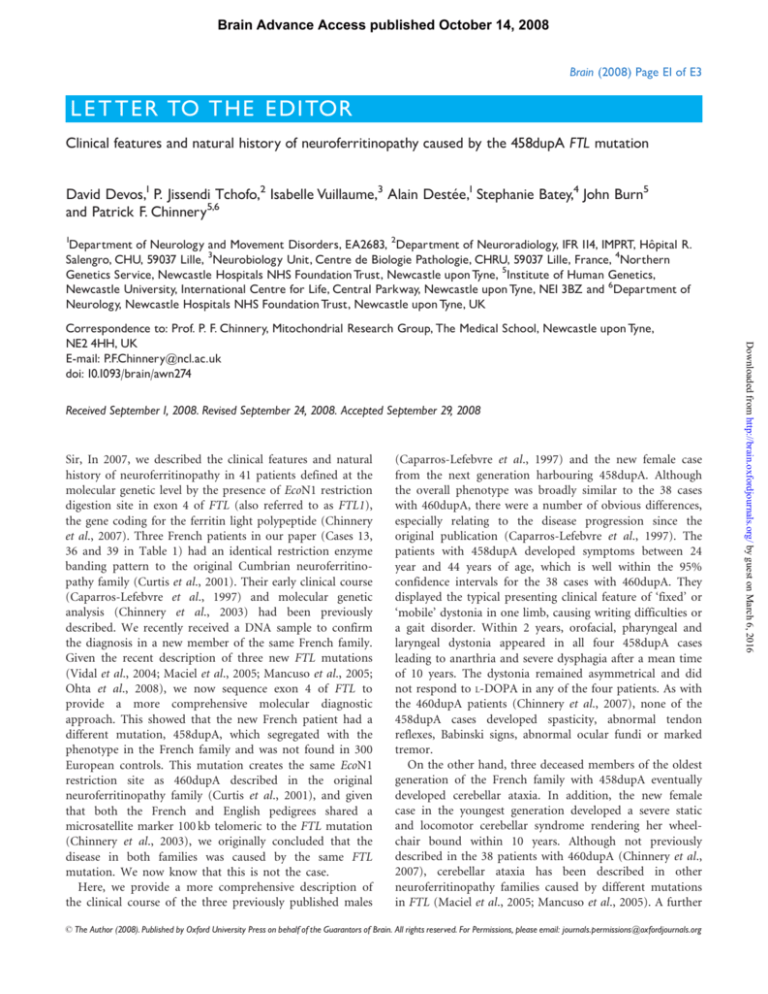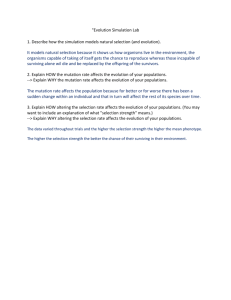
Brain Advance Access published October 14, 2008
Brain (2008) Page E1 of E3
LE T TER TO THE EDITOR
Clinical features and natural history of neuroferritinopathy caused by the 458dupA FTL mutation
David Devos,1 P. Jissendi Tchofo,2 Isabelle Vuillaume,3 Alain Deste¤e,1 Stephanie Batey,4 John Burn5
and Patrick F. Chinnery5,6
1
Department of Neurology and Movement Disorders, EA2683, 2Department of Neuroradiology, IFR 114, IMPRT, Ho“pital R.
Salengro, CHU, 59037 Lille, 3Neurobiology Unit, Centre de Biologie Pathologie, CHRU, 59037 Lille, France, 4Northern
Genetics Service, Newcastle Hospitals NHS Foundation Trust, Newcastle upon Tyne, 5Institute of Human Genetics,
Newcastle University, International Centre for Life, Central Parkway, Newcastle upon Tyne, NE1 3BZ and 6Department of
Neurology, Newcastle Hospitals NHS Foundation Trust, Newcastle upon Tyne, UK
Received September 1, 2008. Revised September 24, 2008. Accepted September 29, 2008
Sir, In 2007, we described the clinical features and natural
history of neuroferritinopathy in 41 patients defined at the
molecular genetic level by the presence of EcoN1 restriction
digestion site in exon 4 of FTL (also referred to as FTL1),
the gene coding for the ferritin light polypeptide (Chinnery
et al., 2007). Three French patients in our paper (Cases 13,
36 and 39 in Table 1) had an identical restriction enzyme
banding pattern to the original Cumbrian neuroferritinopathy family (Curtis et al., 2001). Their early clinical course
(Caparros-Lefebvre et al., 1997) and molecular genetic
analysis (Chinnery et al., 2003) had been previously
described. We recently received a DNA sample to confirm
the diagnosis in a new member of the same French family.
Given the recent description of three new FTL mutations
(Vidal et al., 2004; Maciel et al., 2005; Mancuso et al., 2005;
Ohta et al., 2008), we now sequence exon 4 of FTL to
provide a more comprehensive molecular diagnostic
approach. This showed that the new French patient had a
different mutation, 458dupA, which segregated with the
phenotype in the French family and was not found in 300
European controls. This mutation creates the same EcoN1
restriction site as 460dupA described in the original
neuroferritinopathy family (Curtis et al., 2001), and given
that both the French and English pedigrees shared a
microsatellite marker 100 kb telomeric to the FTL mutation
(Chinnery et al., 2003), we originally concluded that the
disease in both families was caused by the same FTL
mutation. We now know that this is not the case.
Here, we provide a more comprehensive description of
the clinical course of the three previously published males
(Caparros-Lefebvre et al., 1997) and the new female case
from the next generation harbouring 458dupA. Although
the overall phenotype was broadly similar to the 38 cases
with 460dupA, there were a number of obvious differences,
especially relating to the disease progression since the
original publication (Caparros-Lefebvre et al., 1997). The
patients with 458dupA developed symptoms between 24
year and 44 years of age, which is well within the 95%
confidence intervals for the 38 cases with 460dupA. They
displayed the typical presenting clinical feature of ‘fixed’ or
‘mobile’ dystonia in one limb, causing writing difficulties or
a gait disorder. Within 2 years, orofacial, pharyngeal and
laryngeal dystonia appeared in all four 458dupA cases
leading to anarthria and severe dysphagia after a mean time
of 10 years. The dystonia remained asymmetrical and did
not respond to L-DOPA in any of the four patients. As with
the 460dupA patients (Chinnery et al., 2007), none of the
458dupA cases developed spasticity, abnormal tendon
reflexes, Babinski signs, abnormal ocular fundi or marked
tremor.
On the other hand, three deceased members of the oldest
generation of the French family with 458dupA eventually
developed cerebellar ataxia. In addition, the new female
case in the youngest generation developed a severe static
and locomotor cerebellar syndrome rendering her wheelchair bound within 10 years. Although not previously
described in the 38 patients with 460dupA (Chinnery et al.,
2007), cerebellar ataxia has been described in other
neuroferritinopathy families caused by different mutations
in FTL (Maciel et al., 2005; Mancuso et al., 2005). A further
ß The Author (2008). Published by Oxford University Press on behalf of the Guarantors of Brain. All rights reserved. For Permissions, please email: journals.permissions@oxfordjournals.org
Downloaded from http://brain.oxfordjournals.org/ by guest on March 6, 2016
Correspondence to: Prof. P. F. Chinnery, Mitochondrial Research Group, The Medical School, Newcastle upon Tyne,
NE2 4HH, UK
E-mail: P.F.Chinnery@ncl.ac.uk
doi: 10.1093/brain/awn274
Page e2 of e3
Brain (2008)
Letter to the Editor
difference was the rate of clinical progression. 458dupA was
associated with the rapid progression of akineto-rigid
syndrome in the three males, cerebellar ataxia with
hypotonia in the female and cognitive and behavioral
symptoms in all four. This led to a moderate subcorticofrontal dementia (Mattis score ranged from 120 to 128/144;
mean Mini Mental State Examination = 24/30, mean Frontal
Assessment Battery = 13/18) with apathy (mean Lille Apathy
Rating Scale = 8/36, cutoff 17). Two had a diagnosis of
depression. The parkinsonian syndrome was characterized
by no or slight rest tremor, a mild L-DOPA sensitivity of
30%, an off-UPDRS part III ranging from 30 to 44 and
axial involvement responsible for postural instability and
falls. Other atypical features included a limitation of vertical
eye movements and mild dysautonomia (orthostatic hypotension, constipation, urinary incontinence) developing
between 5 years and 10 years. Two patients had a central
apnoea syndrome with restrictive respiratory insufficiency
(Vital Capacity of 64%) causing excessive daytime sleepiness. In one case this was effectively treated with noninvasive positive pressure ventilation. All developed severe
weight loss requiring tube feeding after 10 years in three
cases, contributing to death aged 70 years in one. One
patient died from a cardiomyopathy at the age of 60 years.
Thus, the clinical course in the family with 458dupA, with
parkinsonism and dementia, differs from the remaining 38
patients with 460dupA where there was only slight or no
parkinsonian features and a mild decrease in verbal fluency
(Chinnery et al., 2007).
Structural MR imaging in the family with 458dupA
(Fig. 1A) revealed iron deposition and cystic cavitation of
the basal ganglia in all patients in a pattern characteristic of
neuroferritinopathy (McNeill et al., 2008). This included
the dentate nuclei, where functional MR showed abnormalities consistent with neuronal disruption and altered
membrane turnover (Fig. 1B). Other clinical investigations
revealed similar results to those published previously
(Chinnery et al., 2007). Serum ferritin levels were below
the normal range in all four cases, despite normal
haemoglobin and serum iron levels. Electromyography,
electroretinography and peripheral nerve conduction studies were normal. Visual evoked potentials were slightly
altered in the two patients tested.
These clinical differences are intriguing, given that both
458dupA and 460dupA disrupt the same restriction site and
lead to a shift in the reading frame which lengthens the
ferritin light polypeptide by four residues. However, the
458dupA allele is predicted to alter residue 153 from
histidine to glutamine, disrupting the subsequent amino
sequence. In contrast, residue 153 is wild-type in patients
with the 460dupA allele, which is predicted to change
residue 154 from an arginine to lysine. Residue 154 is a
glutamine in patients with 458dupA, but the subsequent
amino acid sequence is predicted to be identical for both
mutated alleles. Different neurological and psychiatric
features have been described in one family with a missense mutation in FTL (c.474G4A/p.A96T) (Maciel et al.,
2005) including cerebellar ataxia. Although it is difficult to
reach a firm conclusion at this stage, our observations in
the French family with 458dupA support the view that
subtle differences in a critical region of the ferritin protein
sequence modulate the phenotype of neuroferritinopathy.
References
Caparros-Lefebvre D, Destee A, Petit H. Late onset familial dystonia: could
mitochondrial deficits induce a diffuse lesioning process of the
whole basal ganglia system? J Neurol Neurosurg Psychiatry 1997; 63:
196–203.
Chinnery PF, Crompton DE, Birchall D, Jackson MJ, Coulthard A,
Lombes A, et al. Clinical features and natural history of neuroferritinopathy caused by the FTL1 460InsA mutation. Brain 2007; 130: 110–19.
Chinnery PF, Curtis AR, Fey C, Coulthard A, Crompton D, Curtis A, et al.
Neuroferritinopathy in a French family with late onset dominant
dystonia. J Med Genet 2003; 40: e69.
Downloaded from http://brain.oxfordjournals.org/ by guest on March 6, 2016
Fig. 1 (A) Axial-T2 -weighted image showing high signal within caudate and lenticular nuclei associated with cystic cavitation.
(B) The spectrum acquired with a single voxel technique at long echo time (144 ms) in the deep left cerebellum including the dentate
nucleus shows a decrease of NAA/Cr (1.07) and Cho/Cr (0.68) ratios related to neuronal dysfunction and a disturbance of neuronal
membrane turnover.
Letter to the Editor
Curtis AR, Fey C, Morris CM, Bindoff LA, Ince PG, Chinnery PF, et al.
Mutation in the gene encoding ferritin light polypeptide
causes dominant adult-onset basal ganglia disease. Nat Genet 2001;
28: 350–4.
Maciel P, Cruz VT, Constante M, Iniesta I, Costa MC, Gallati S, et al.
Neuroferritinopathy: missense mutation in FTL causing early-onset
bilateral pallidal involvement. Neurology 2005; 65: 603–5.
Mancuso M, Davidzon G, Kurlan RM, Tawil R, Bonilla E, Di Mauro S,
et al. Hereditary ferritinopathy: a novel mutation, its cellular
pathology, and pathogenetic insights. J Neuropathol Exp Neurol 2005;
64: 280–94.
Brain (2008)
Page e3 of e3
McNeill A, Birchall D, Hayflick SJ, Gregory A, Schenk JF, Zimmerman EA,
et al. T2 and FSE MRI distinguishes four subtypes of neurodegeneration with brain iron accumulation. Neurology 2008; 70: 1614–19.
Ohta E, Nagasaka T, Shindo K, Toma S, Nagasaka K, Ohta K, et al.
Neuroferritinopathy in a Japanese family with a duplication in the
ferritin light chain gene. Neurology 2008; 70: 1493–4.
Vidal R, Ghetti B, Takao M, Brefel-Courbon C, Uro-Coste E, Glazier BS,
et al. Intracellular ferritin accumulation in neural and extraneural tissue
characterizes a neurodegenerative disease associated with a mutation in
the ferritin light polypeptide gene. J Neuropathol Exp Neurol 2004; 63:
363–80.
Downloaded from http://brain.oxfordjournals.org/ by guest on March 6, 2016










